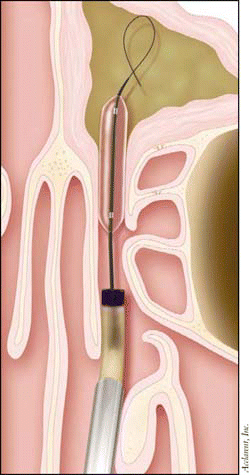A new, minimally invasive technology known as balloon sinuplasty can safely and successfully dilate blocked sinus ostia in select patients with chronic sinusitis, according to early observations in a small number of patients.
Explore This Issue
May 2006Researchers agree that the results of larger, longer studies are needed before anyone will know whether the technology-which involves threading a small, flexible balloon-tipped catheter through the sinus passageways and expanding the balloon to gently dilate the openings of the sinuses-will change standard treatment of chronic sinusitis.
Gentle Dilation, Less Trauma
But early studies suggest that the technology is less invasive than conventional endoscopic techniques, said William E. Bolger, MD, a rhinologist and sinus surgeon based in Bethesda, Md. Dr. Bolger headed the preclinical and pilot safety and feasibility studies that led to the recent Food and Drug Administration approval of the technology, known as the Relieva Balloon Sinuplasty System.

The device appears to impart less trauma, while preserving normal anatomy and mucosal tissue, he said. Less trauma during surgery tends to be associated with less bleeding, less pain, and perhaps less need for deep anesthesia. Recovery time could also be shorter, although more clinical testing is needed.
Andrew N. Goldberg, MD, Associate Professor in the Department of Otolaryngology-Head and Neck Surgery at the University of California, San Francisco, agreed. The rationale for the device is that it gently dilates the sinus ostia to allow for better ventilation and drainage. There is minimal damage to the mucosa and minimal bleeding and trauma as compared to standard endoscopic sinus surgical techniques.
The device appears to be particularly helpful for the frontal sinuses where it provides gentle dilation of the outflow tract with remodeling of adjacent cells, added Dr. Goldberg, who is participating in postmarketing studies of the device.
How it Works
The technology works much like balloon angioplasty to open up fat-clogged coronary arteries. First, the catheter is introduced into the target sinus under endoscopic visualization. A flexible guidewire is introduced through the catheter and gently advanced into the target sinus under fluoroscopic guidance. Then, a balloon-tipped catheter is positioned across the blocked ostium, with its position confirmed using fluoroscopy. The balloon is gradually inflated to gently restructure the blocked ostium. The system is removed, leaving the ostium open and allowing the return of normal sinus drainage and function.
Leave a Reply